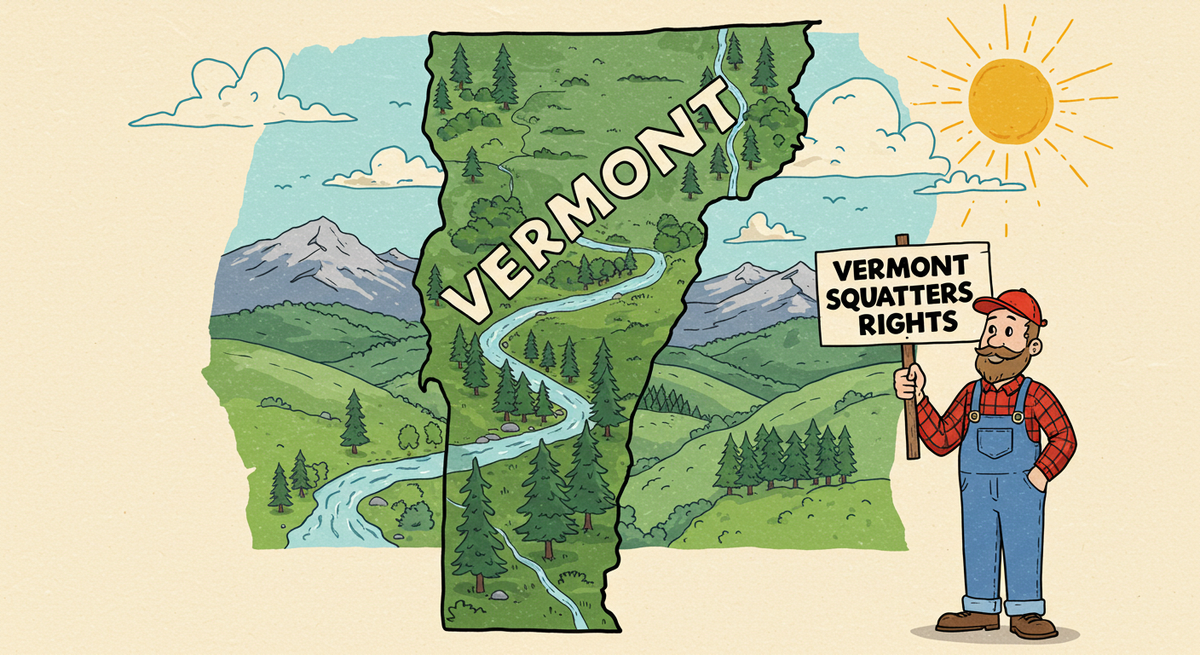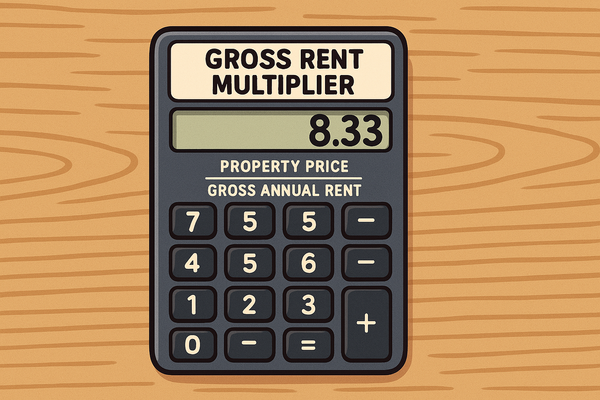Vermont Squatters Rights Guide: Understanding Adverse Possession Laws
A squatter must occupy the property for 15 consecutive years in Vermont in order to make a successful adverse possession claim

From the audacious squatters who infiltrated Burlington campus housing during the 2025 winter break causing $10,000 in damages, to 78-year-old Carolyn Blake-Bashaw's harrowing months-long nightmare battling unauthorized occupants who took over her duplex while she was on her honeymoon, to Marjorie Burbank's year-long legal struggle to remove drug-using squatters from her home—Vermont's property owners face a growing crisis at the intersection of housing insecurity and tenant-friendly laws.
These disturbing cases illustrate the urgent need for property owners to understand Vermont's complex squatters' rights landscape, where unauthorized occupants can quickly transform from trespassers to tenants with substantial legal protections, creating financial and emotional devastation for legitimate homeowners caught in a bureaucratic web of eviction proceedings.
Introduction to Squatters' Rights in Vermont
- Definition of squatters vs. trespassers in Vermont: In Vermont, squatters are individuals who occupy a property without legal permission but may eventually claim ownership through adverse possession, while trespassers are unauthorized occupants with no intent to claim ownership rights.
- Basic overview of adverse possession in Vermont: Vermont law allows for the transfer of property ownership through adverse possession after 15 years of continuous, open, notorious, and hostile occupation.
- Why property owners should understand these laws: Vermont's tenant-friendly laws can create significant challenges for property owners, as demonstrated by recent cases where legitimate owners faced lengthy legal battles and substantial financial losses when removing unauthorized occupants.
- Historical purpose of adverse possession laws: Adverse possession laws were originally established to ensure productive land use and resolve boundary disputes, particularly in rural areas common throughout Vermont.
Squatter Snippet: Real Case from Vermont
In 2018, Springfield, Vermont resident Carolyn Blake-Bashaw, a 78-year-old widow, returned from her two-week honeymoon to discover unauthorized occupants in her Pine Street duplex. Her stepson had given these individuals permission to stay while she was away. When Carolyn tried to remove them, responding police officers delivered shocking news: "You are now a landlord," they explained.
In Vermont, anyone who arrives with a suitcase and stays for three days can claim residency rights, requiring a formal eviction process.
Duly noted.
The financial burden was devastating for Carolyn, who lived on Social Security. She was forced to pay for heat, electricity, water, and sewer for the apartment while receiving no rent. The eviction process cost her $200 just to file, and she missed a court date due to illness, further extending the timeline.
Eventually, Carolyn paid the squatters to leave, only to discover approximately $7,000 in damage to her property, including sewage backup, broken doors, holes in walls, cigarette burns, and stolen personal possessions. This case highlights why understanding Vermont's squatter laws is critical for property owners.
Key Timeline: Statutory Period in Vermont
- Required occupation period: A squatter must occupy the property for 15 consecutive years in Vermont in order to make a successful adverse possession claim
- Continuous possession requirement: Occupation without significant gaps
- Comparison with neighboring states:
- Timeline exceptions:
- Military service (Servicemembers Civil Relief Act can pause the timeline)
- Charitable use of property (may affect calculation period)
CHART: Adverse Possession Timeline Comparison
| State | Required Years | Special Conditions |
|---|---|---|
| Vermont | 15 years | No reduction for color of title |
| Maine | 20 years | Tax payment typically required |
| New Hampshire | 20 years | Requires property tax payment |
| Massachusetts | 20 years | Color of title may reduce to 7 years |
Quick Guide for Property Owners
Vermont property owners face unique challenges with unauthorized occupants due to the state's tenant-friendly laws. Recent incidents, like the Burlington campus housing case in early 2025, demonstrate how predictable vacancy patterns in student housing create opportunities for squatters to cause extensive damage.
In January 2025, squatters broke into the basement of a student property during the holiday break, causing approximately $10,000 in damage and potentially burglarizing student apartments above.
Burlington Police Chief John Murad emphasized that the timing wasn't coincidental: "In an area that's predominantly students, it's pretty clear when there aren't going to be people there, and that's just an invitation for people to break in and take stuff."
- Know your timeline: Squatters can claim rights after 15 years of continuous occupation
- Documentation matters: Keep property records, tax receipts, and inspection logs
- Regular monitoring required: Vacant properties are most vulnerable
- Legal obligation: Self-help eviction methods are illegal in Vermont
- Act quickly: The longer squatters remain, the stronger their potential claim
- Proper notices: Follow legal procedures when removing unauthorized occupants
Prevention: Protecting Your Property
In Vermont, squatters often target predictably vacant properties, such as student housing during school breaks and seasonal vacation homes. The Burlington campus housing incident of January 2025 illustrates how squatters exploit these patterns, causing significant property damage including fire damage, burglary, and vandalism.
Vermont courts consider regular property inspection and maintenance as evidence against adverse possession claims, with documented visits interrupting the required continuous possession timeline.
- Regular inspections:
- Visit property at least quarterly
- Document each visit with photos/notes
- Effective security measures:
- Secure all entry points
- Consider alarm systems
- Install motion-activated lighting
- Clear signage:
- Post "No Trespassing" signs visibly
- Mark property boundaries clearly
- Property management options:
- Hire professional management for vacant properties
- Consider rental options for long-term vacancies
- Documentation practices:
- Keep tax payment records
- Maintain utility connections
- Take dated photographs regularly
CHART: Property Risk Assessment Matrix
| Property Type | Risk Level | Recommended Prevention | Estimated Cost |
|---|---|---|---|
| Vacant Land | Medium | Fencing, signage, quarterly inspections | $-$$ |
| Abandoned Building | High | Security systems, reinforced entries, monthly checks | $$-$$$ |
| Seasonal Property | High | Property management, smart monitoring, security systems | $$-$$$ |
| Investment Property | Medium | Regular tenant occupancy, property management | $$-$$$ |
Removing Squatters: Step-by-Step Process
Vermont law requires property owners to follow formal eviction procedures even for unauthorized occupants. As demonstrated in the Springfield case with 78-year-old Carolyn Blake-Bashaw, police will not remove individuals who have established residency (even illegally), creating a burdensome legal process for legitimate owners.
Under Vermont Statutes, self-help eviction methods are strictly prohibited and can expose property owners to civil liability, forcing them to treat squatters similarly to legitimate tenants during the removal process.
- Document the situation:
- Take photos/video of occupation
- Gather ownership documents
- Issue proper written notice to vacate
- 14-day notice for nonpayment claims
- 30-day notice for lease violations
- 14-day unconditional notice for illegal activity
- File appropriate legal complaint:
- Complaint for ejectment with Vermont Superior Court
- Include all required documentation
- Attend court hearing
- If successful, obtain writ of possession
- Sheriff enforces removal, not property owner
- What NOT to do:
- Do not change locks yourself
- Do not shut off utilities
- Do not remove squatter's belongings
- Do not threaten or intimidate
- Do not use physical force
- Timeline expectations:
- Notice period: 14-30 days
- Court processing: 2-8 weeks
- Eviction enforcement: 14 days after judgment
CHART: Eviction Process Timeline
The Vermont eviction process for removing squatters follows specific civil procedure requirements under Title 12 of Vermont Statutes Annotated, with mandatory waiting periods between each step. Recent court data from Vermont's judicial system indicates typical processing times of 4-12 weeks, though complex cases may take longer.
Unlike some states, Vermont does not offer expedited options specifically for squatter removal, treating all unauthorized occupants as tenants requiring full eviction proceedings.
[Discovery of Squatter] → [Documentation: 1-2 days] → [Notice to Vacate: 14-30 days] →
[Court Filing: 1 day] → [Waiting for Hearing: 2-8 weeks] → [Court Hearing: 1 day] →
[If successful, Wait for Order: 3-7 days] → [Sheriff Enforcement: 14 days] → [Property Returned]
Total estimated timeline: 4-12 weeks
Legal Requirements for Adverse Possession
Vermont courts evaluate adverse possession claims using the traditional "OCEAN" criteria (Open, Continuous, Exclusive, Adverse, Notorious), with specific interpretations developed through Vermont case law.
In Mahoney v. Tara, LLC (2014), the Vermont Supreme Court clarified that the 15-year statutory period in 12 V.S.A. § 501 governs adverse possession claims, while also addressing how property used for charitable purposes affects timeline calculations.
Vermont courts require clear and convincing evidence for each element throughout the entire 15-year period, with failure on any single criterion defeating the claim.
- Hostile Claim
- Definition: Occupation without permission from the true owner
- Vermont follows an "objective" standard for hostility, focusing on unauthorized occupation rather than the squatter's intent
- Actual Possession
- Physical occupation of the property
- Evidence includes establishing residence, making improvements, or using land productively
- Open and Notorious Possession
- Visible occupation apparent to community members and neighbors
- Courts look for evidence the possession would be noticeable during reasonable inspection
- Exclusive Possession
- Squatter must possess the property as sole occupant, excluding others
- Cannot share occupation with the true owner or the public
- Continuous Possession
- Uninterrupted occupation for the entire 15-year period
- Any abandonment resets the 15-year clock to zero
CHART: Adverse Possession Requirements Matrix
| Requirement | Required in Vermont? | Evidence Courts Accept | Common Pitfalls |
|---|---|---|---|
| Hostile Claim | Yes | Unauthorized occupation, no rental agreement | Owner permission defeats claim |
| Actual Possession | Yes | Residence establishment, property improvements | Minimal or sporadic use insufficient |
| Open & Notorious | Yes | Visible occupation, community recognition | Concealed occupation disqualifies |
| Exclusive | Yes | Sole occupant control, excluding others | Shared use with public/owner fails |
| Continuous | Yes | Uninterrupted for 15 years, consistent use | Any abandonment resets timeline |
Frequently Asked Questions
- "Can I remove squatters myself?"
- No, self-help eviction is illegal in Vermont
- Must follow legal eviction process
- "Do squatters have to pay property taxes?"
- Tax payment may strengthen adverse possession claim
- Not strictly required in Vermont, unlike some states
- "What's the difference between a squatter and a trespasser?"
- Trespassers: Short-term unauthorized presence (less than 7 days)
- Squatters: Ongoing occupation with potential adverse possession claim
- "Who should I contact first - police or sheriff?"
- For immediate safety concerns: Police
- For eviction enforcement: Sheriff
- "Can squatters claim abandoned property?"
- Yes, if all adverse possession requirements are met
- Abandonment may actually strengthen their claim
- "How quickly can I evict a squatter?"
- Typical timeline: 4-12 weeks
- Factors affecting timeline: court schedule, appeals, evidence quality
CHART: Decision Tree for Property Owners
Vermont law distinguishes between criminal trespass and civil adverse possession, with timing being the critical factor. Under Vermont Statutes, trespassing can result in up to 3 years in jail and up to a $2,000 fine, but unauthorized occupants who remain for more than 7 days typically require civil eviction procedures.
Law enforcement in Vermont has specific protocols, with police limited to removing recent trespassers while only sheriffs can execute court-ordered evictions.
Discovered Someone on Your Property
├── Emergency/Dangerous Situation? → Yes → Call Police
│ └── No ↓
├── Recent Entry (Less than 7 days)? → Yes → Call Police (Trespasser)
│ └── No ↓
├── Evidence of Established Occupation? → Yes → Legal Eviction Process Required
│ └── No ↓
└── Uncertain Situation → Consult Attorney Before Taking Action
Recent Legislative Changes in Vermont
Vermont has shown recent legislative interest in reforming adverse possession laws. Senate Bill 73 (S0073) was introduced in the 2025-2026 Regular Session on February 18, 2025.
This Republican-sponsored bill proposes requiring notice of an adverse possession claim to the record property owner, which would significantly affect how adverse possession claims proceed in the state. As of March 2025, the bill has been read once and referred to the Committee on Judiciary.
Prior legislative efforts have focused on balancing tenant protections with property owner rights, particularly in response to cases like Carolyn Blake-Bashaw's in Springfield, where elderly homeowners faced significant financial hardship when unable to quickly remove unauthorized occupants.
- Recently Passed Laws:
- Senate Bill 73 (pending): Introduced February 18, 2025, would require notification to property owners of adverse possession claims
- Impact on property owners: Would provide earlier warning of potential claims
- Effective date: Not yet enacted, currently in committee
- Legislative Trends:
- Vermont is considering reforms that provide more protection to legitimate property owners
- National trend toward requiring notification to record owners of adverse possession claims
State-Specific Considerations
- Color of Title in Vermont:
- Definition: Irregular ownership document
- Impact on statutory period: No reduction (remains 15 years)
- Can strengthen claim but not mandatory
- Burden of proof requirements:
- Squatter must prove all elements of adverse possession
- Clear and convincing evidence standard in Vermont courts
- Recent legal developments:
- Mahoney v. Tara, LLC (2014): Clarified statute of limitations and charitable use exemptions
- Senate Bill 73 (pending): Would require notification to property owners
- How Vermont differs from neighboring states:
- Shorter statutory period (15 years vs. 20 years in ME, NH, MA)
- No strict tax payment requirement (unlike some neighboring states)
- Strong tenant protections apply even to unauthorized occupants
CHART: Vermont vs. Neighboring States Comparison
| Factor | Vermont | Maine | New Hampshire | Massachusetts |
|---|---|---|---|---|
| Statutory Period | 15 years | 20 years | 20 years | 20 years |
| Color of Title Impact | No reduction | No reduction | No reduction | May reduce to 7 years |
| Tax Payment Required | No (but helpful) | Yes | Yes | No (but helpful) |
| Special Conditions | Charitable use exemptions | Must be visible and notorious | Stricter "hostile" requirement | Stricter "actual use" standard |
| Strictness Rating | 3.5 | 4 | 4 | 3 |
Advanced Legal Process
- Court proceedings often require attorney representation
- Evidence requirements include documentation of ownership, property condition, and occupation history
- Potential outcomes range from immediate removal to payment negotiations
- Monetary judgments for property damage may be difficult to collect
- Impact on property title can persist if adverse possession claim is recorded
- Special provisions protect active military members under federal law
Real-World Examples
- The Burlington campus housing incident (January 2025): Squatters caused $10,000 in damage to student housing during holiday break
- Carolyn Blake-Bashaw case (Springfield, 2018): 78-year-old homeowner fought months-long battle to remove squatters from her duplex
- Marjorie Burbank case (Springfield, 2018): 76-year-old resident spent an entire year completing eviction process against drug users brought in by a tenant
Resources
- Current Vermont Squatters Rights Laws:
- https://legislature.vermont.gov/statutes/chapter/12/023
- Last updated: 2024
- Recent/Pending Legislation:
- https://legiscan.com/VT/text/S0073/id/3127593
- Bill status: In committee
Legal Disclaimer
DISCLAIMER: The information provided in this guide is for general informational purposes only and should not be construed as legal advice on any subject matter. The content contained herein does not establish an attorney-client relationship.
This guide about Vermont squatters' rights and adverse possession laws is intended to provide general information and should not be relied upon as legal advice. Laws and regulations regarding property rights, adverse possession, and eviction procedures vary by jurisdiction and may change over time. The information presented here may not reflect the most current legal developments or address your specific situation.
No reader should act or refrain from acting based on information in this guide without first seeking professional legal advice. Property owners dealing with squatters should consult with a qualified attorney licensed to practice in their jurisdiction for advice tailored to their particular circumstances.
The authors, publishers, and distributors of this guide expressly disclaim all liability in respect to actions taken or not taken based on any or all of the contents of this document. They shall not be responsible for any errors or omissions in this information or any consequences arising from its use.
This guide is provided "as is" without warranty of any kind, either express or implied, including but not limited to implied warranties of merchantability, fitness for a particular purpose, or non-infringement.
Copyright © 2025 LandlordDoc.com. All rights reserved.





